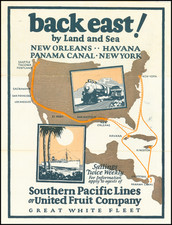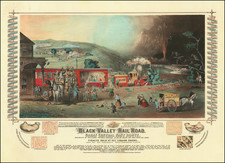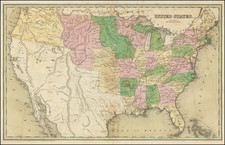This 1755 map, published by J. Hinton for the Universal Magazine in London, presents a detailed and vivid portrayal of the geopolitical landscape of early North America during the French and Indian War. It is an early reduced copy of John Mitchell's influential map, capturing the essence of the colonial territories and fortifications that shaped the continent's history.
The mid-18th century was a period of intense rivalry and territorial expansion in North America, primarily between the British and French empires. This map, with its attention to boundaries and fortifications, reflects the volatile nature of colonial claims and conflicts. The delineation of the states of Virginia, North Carolina, South Carolina, and Georgia, extending to the Mississippi, along with the unique identification of "The South Part of South Carolina," provides a nuanced understanding of colonial territorial aspirations. The notation of Earl Granville's Property, stretching from Albemarle Sound to the Mississippi, underscores the personal and political interests that drove colonial expansion.
The map's rich annotations and color scheme, reminiscent of early Mitchell maps, offer a window into the complexities of colonial cartography. The depiction of at least 30 early French and English forts, including a detailed inset plan of Fort Frederick at Crown Point, built by the French in 1731, highlights the strategic importance of military installations in the colonial landscape. The inclusion of historical notes, such as the Virginia-New England border of 1606, the Carolina Charter boundary of 1665, and the boundaries stipulated in 1738 for Georgia, offers a layered historical perspective, tracing the evolution of colonial borders over time.
The detailed representation of provinces like Maine and Massachusetts Bay, and the delineation of New Jersey and Delaware County, offer insights into the colonial administration and geographical understanding of the era. This map not only serves as a testament to the cartographic skills of the period but also as a visual narrative of the complex and often contested colonial history of North America.









![United States History-Map (Five historical maps, including Toscanelli's Map of 1474) [Cover title:] Bacon's Excelsior Wall Atlases - America](https://storage.googleapis.com/raremaps/img/small/88839.jpg)
![A New and Correct Map of North America with the West India Islands, Divided According to the Last Treaty of Peace ... 20th of Jan. 1783 ... Particularly Distinguished the Thirteen Provinces which Compose the United States . . . [With annotations describing Cumberland, Tennessee, Kentucky etc.]](https://storage.googleapis.com/raremaps/img/small/41651.jpg)



